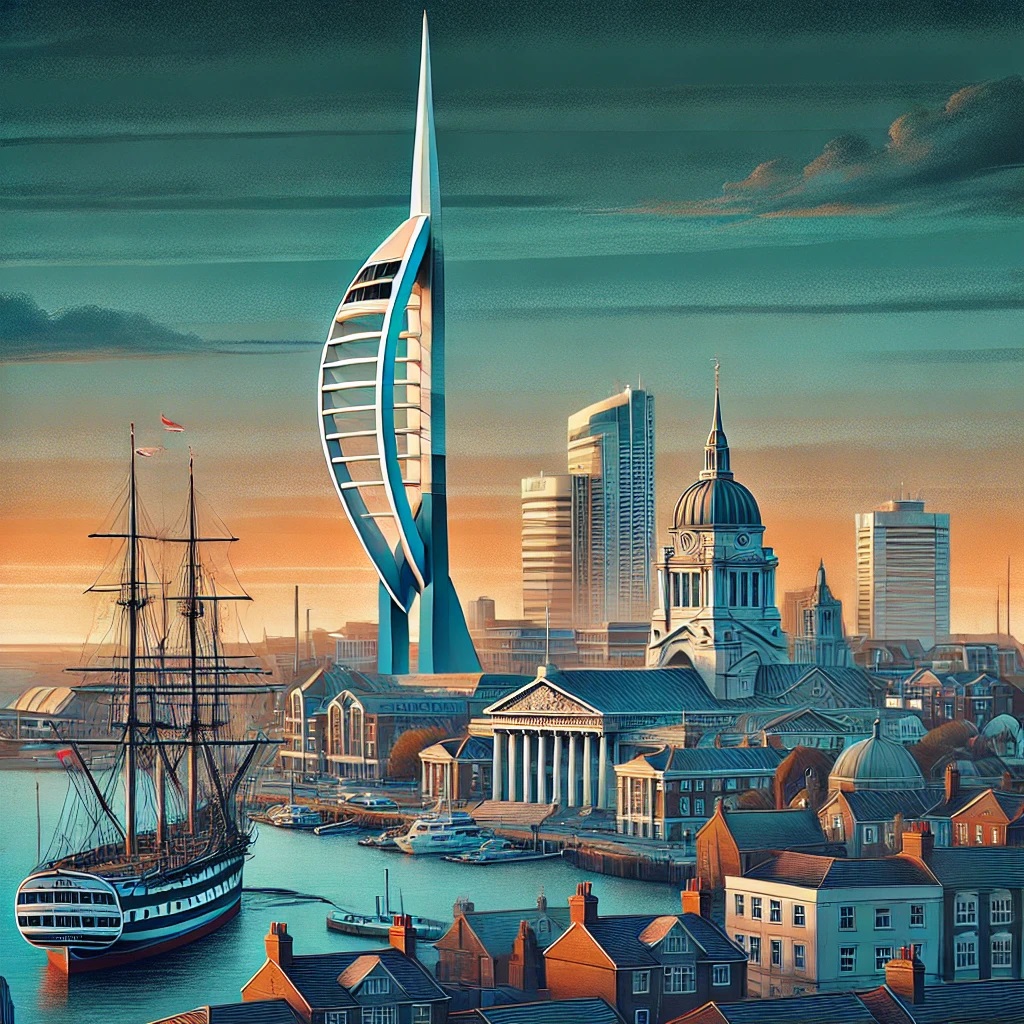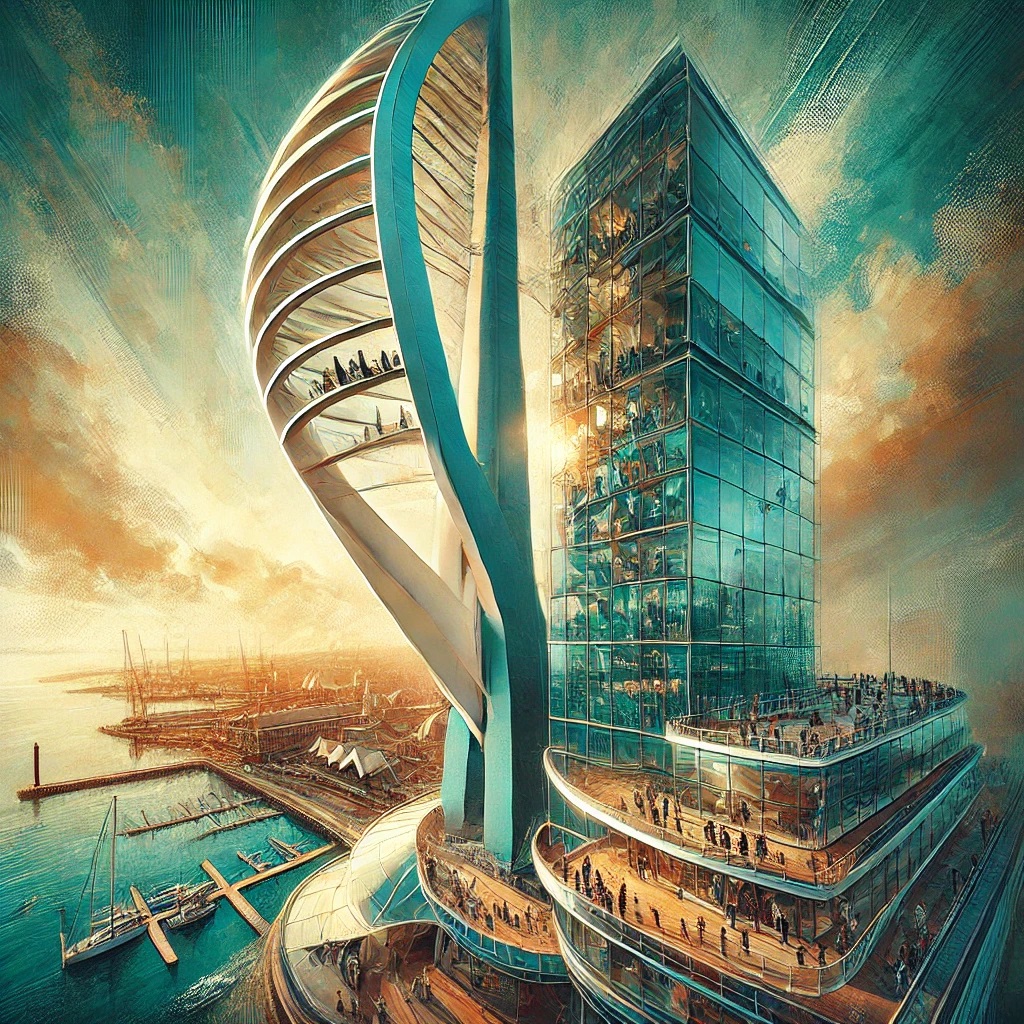
Portsmouth’s Most Iconic Architecture: A Tour of Historic Buildings
The Historic Dockyard: Naval Prowess in Architecture

HMS Victory: Nelson’s Flagship
HMS Victory, launched in 1765, stands as a testament to 18th-century naval architecture. This first-rate ship of the line, famously Lord Nelson’s flagship at the Battle of Trafalgar, showcases the pinnacle of wooden warship design. Its intricate rigging, multiple gun decks, and ornate stern carvings exemplify the craftsmanship of the era.
The Mary Rose Museum: Tudor Engineering
The Mary Rose Museum houses the remains of Henry VIII’s flagship, which sank in 1545. The museum’s architecture, designed to evoke the hull of a ship, provides a controlled environment for the preserved Tudor vessel. This modern structure seamlessly integrates with the historic dockyard, offering visitors a glimpse into 16th-century maritime engineering.
Boathouse 4: Blending Old and New
Boathouse 4, originally constructed in the 1930s, has been repurposed as an interactive museum. The restoration project maintains the building’s industrial character while incorporating contemporary design elements. This adaptive reuse exemplifies Portsmouth’s commitment to preserving its naval heritage while embracing modern functionality.
Old Portsmouth: Medieval Marvels

The Round Tower: Coastal Defense Icon
Built in the 15th century, the Round Tower formed a crucial part of Portsmouth’s sea defenses. Its circular design, uncommon for English fortifications of the time, offered superior cannon placement and resilience against artillery fire. Today, it serves as a reminder of the city’s strategic importance throughout history.
Square Tower: From Artillery to Art
The Square Tower, despite its name, is another round fortification dating back to 1494. Originally serving as a residence for the Governor of Portsmouth, it later became a gunpowder storage facility. In recent years, it has been repurposed as an exhibition space, showcasing local art and hosting cultural events.
Portsmouth Cathedral: Gothic Grandeur
Portsmouth Cathedral, also known as the Cathedral of St. Thomas of Canterbury, blends Romanesque and Gothic architectural styles. Its construction spanned several centuries, with the nave dating back to the 12th century and the tower completed in the 1700s. The cathedral’s diverse architectural elements reflect the city’s evolving history.
Southsea Castle: Henry VIII’s Coastal Fortress

The Keep: Strategic Design
Southsea Castle, commissioned by Henry VIII in 1544, features a central keep designed for both defensive and residential purposes. Its thick walls and strategically placed gun ports demonstrate the adaptation of castle design to artillery warfare. The keep’s layout allowed for efficient defense coordination during potential attacks.
The Lighthouse: Guiding Ships Since 1822
The lighthouse atop Southsea Castle, added in 1822, marks a shift from purely military function to maritime safety. Its octagonal design and lantern room showcase early 19th-century lighthouse architecture. The lighthouse continues to operate, guiding vessels through the Solent.
Underground Tunnels: World War II Adaptations
During World War II, Southsea Castle’s medieval structure was augmented with underground tunnels and bunkers. These additions, while utilitarian in design, illustrate how historic buildings were adapted to meet modern warfare requirements. The tunnels now offer visitors insight into 20th-century military engineering.
Spinnaker Tower: Modern Maritime Landmark

Architectural Inspiration: Sail Design
The Spinnaker Tower, completed in 2005, draws inspiration from Portsmouth’s maritime heritage. Its design mimics a ship’s sail, with a sleek, curved structure rising 170 meters above the harbour. The tower’s form represents a departure from traditional observation tower designs, creating a unique silhouette on the city’s skyline.
Viewing Decks: Panoramic City Vistas
The tower’s three viewing decks, at different elevations, offer panoramic views of Portsmouth and beyond. The highest deck features a glass floor, providing a thrilling perspective of the city below. These viewing platforms demonstrate how modern architecture can enhance the visitor experience and showcase urban landscapes.
Engineering Feat: Construction Challenges
The construction of the Spinnaker Tower presented numerous engineering challenges, including its location on reclaimed land and exposure to strong winds. The use of post-tensioned concrete and a sophisticated damping system ensures the tower’s stability. These technical solutions highlight the advancements in modern architectural engineering.
Residential Gems: Homes with History

Charles Dickens’ Birthplace: Literary Legacy
The modest terrace house where Charles Dickens was born in 1812 represents early 19th-century working-class architecture. Its simple Georgian design, with symmetrical windows and a central door, contrasts with the grander buildings of the era. The house has been preserved to reflect the living conditions of Dickens’ time, offering insights into domestic architecture of the period.
Southsea’s Victorian Terraces: Seaside Elegance
Southsea’s Victorian terraces, built in the late 19th century, exemplify the architectural trends of seaside resorts. These homes feature ornate ironwork balconies, bay windows, and decorative brickwork. The uniform yet individually detailed facades create a harmonious streetscape that characterises much of Southsea’s charm.
Eastney Beam Engine House: Industrial Heritage
The Eastney Beam Engine House, constructed in 1887, represents the Victorian approach to industrial architecture. Its red brick exterior and large arched windows are typical of the period’s utilitarian yet aesthetically pleasing design. The building housed steam-powered engines for the city’s sewage system, demonstrating how architectural form followed function in industrial settings.
Summary: Portsmouth’s Architectural Timeline
Portsmouth’s architecture presents a chronological journey through British history. From medieval fortifications to Tudor shipbuilding, Georgian townhouses to Victorian seaside developments, and wartime adaptations to modern landmarks, the city’s buildings narrate centuries of technological, social, and artistic evolution. This architectural diversity not only preserves Portsmouth’s heritage but also continues to shape its identity as a historic maritime city embracing the future.
FAQs about Portsmouth’s Architecture
Best time to visit these landmarks
The optimal period for visiting Portsmouth’s architectural landmarks is typically between May and September when the weather is milder and daylight hours are longer. However, many sites are open year-round, with indoor attractions like the Mary Rose Museum providing excellent options during inclement weather.
Accessibility information
Most of Portsmouth’s major architectural sites have made efforts to improve accessibility. The Spinnaker Tower and Mary Rose Museum offer wheelchair access and lifts. Historic sites like Southsea Castle have limited accessibility due to their original design, but often provide alternative routes or virtual tours. It is advisable to check specific accessibility information for each site before visiting.
Photography policies
Photography policies vary among Portsmouth’s landmarks. Generally, exterior photography is permitted for personal use. Inside museums and historic buildings, policies may restrict flash photography or tripod use. The Mary Rose Museum prohibits photography in certain areas to protect sensitive artefacts. It is recommended to consult each site’s specific guidelines upon entry.
Discover Portsmouth’s historic charm and iconic architecture, and make it your home! At NEXA Properties, we specialize in helping you find the perfect property that matches your lifestyle in this vibrant city. Contact us today to explore our listings and start your journey toward owning a piece of Portsmouth’s rich history.